Abundance and characteristics of microplastics in shellf ish from Jiaozhou Bay, China*
Kangning ZHANG , Junhua LIANG , Tao LIU , Qingjie LI , Mingliang ZHU ,Shan ZHENG , Xiaoxia SUN ,3,4,**
1 Jiaozhou Bay National Marine Ecosystem Research Station, Institute of Oceanology, Chinese Academy of Sciences, Qingdao 266071, China
2 Laboratory for Marine Ecology and Environmental Science, Pilot National Laboratory for Marine Science and Technology(Qingdao), Qingdao 266237, China
3 Center for Ocean Mega-Science, Institute of Oceanology, Chinese Academy of Sciences, Qingdao 266071, China
4 University of Chinese Academy of Sciences, Beijing 100049, China
Abstract As an emerging pollutant, the presence of microplastics in marine organisms has been concerned increasingly. Shellf ish, which are both economically and ecologically important, are of particular concern.In this study, we investigated the microplastic pollution in wild and farmed oysters ( Crassostrea gigas) and clams ( Ruditapes philippinarum) in the Jiaozhou Bay, China, for the f irst time. We found the microplastic pollution in shellf ish in Jiaozhou Bay was at a moderate level. The abundance of microplastics in shellf ish ranged from 0.16 to 12.09 items/g (wet weight, ww) or 1 to 9 items/ind. The average abundance of the ingested microplastics was 1.21 items/g (or 2.17 items/ind.) in all shellf ish, 1.51 items/g (or 2.00 items/ind.) in clams and 0.92 items/g (or 2.34 items/ind.) in oysters. The abundance of microplastics in clams was signif icantly higher than that in oysters. Most microplastics (92.97%) were f ibers, followed by fragments.The predominant color of the microplastics was black (42.97%), followed by blue, transparent, and red.Cellophane and polyethylene terephthalate (PET) dominated the microplastic composition. According to shellf ish consumption, it can be inferred that the average microplastic consumption through Chinese diet is 1.27×10 3 items per capita per year.
Keyword: microplastics; bivalves; Jiaozhou Bay; risk assessment
1 INTRODUCTION
In recent years, microplastics (plastic debris less than 5 mm in diameter) (Arthur et al., 2009), as emerging pollutants, have become a research hotspot in the f ields of ecology and environmental science globally. Microplastics can persist in the ocean due to their stable chemical properties and long degradation times (Cole et al., 2011). They have been found in an increasing number of organisms, such as zooplankton(Desforges et al., 2015), benthos (polychaetes, bivalves,and crustaceans) (Murray and Cowie, 2011; Goldstein and Goodwin, 2013; Lusher, 2015; van Cauwenberghe et al., 2015a), nekton (pelagic and demersal f ish)(Lusher et al., 2013), seabirds (Tourinho et al., 2010;Provencher et al., 2014), and large marine mammals(Besseling et al., 2015). There is some evidence to suggest adverse impacts on the ocean ecosystem from microplastics ingested by marine organisms. In addition to physical damage to the intestinal wall caused by microplastics, there are also chemical impacts. Microplastics are not only a source of marine pollutants but also carriers of deleterious pollutants. In addition to the release of plasticizers and other harmful substances (Hirai et al., 2011), microplastics can accumulate organic pollutants, heavy metals or pathogenic microorganisms from the surrounding environment and transfer them along the food chain in the ocean (Mato et al., 2001; Masó et al., 2003). With the expansion of this research area, scholars have discovered that the hazard posed by microplastics to marine ecosystems may be far higher than those posed by visible plastics may. Density microplastics settle naturally in seawater. Adherent biota can alter the microplastic density, causing them to sink into the seaf loor (van Cauwenberghe et al., 2015b). Therefore,deposit feeders are particularly vulnerable to plastic debris, but research on deposit feeders is limited.
Shellf ish, typical deposit feeders in the ocean, are ecologically important. They are key players in the food chain, preying on plankton, which are food sources for many large organisms. Therefore, bivalves are often used in experiments as model organisms for studying the ecological hazards of microplastics. Particles ingested by mistake can be transferred to and accumulate in tissues and organs and aff ect physiological activity.The enzyme activity, growth, development, and reproduction of bivalves have been shown to be impacted by such particles. Sussarellu et al. (2016)indicated that oyster reproduction and feeding behaviors can be aff ected by exposure to polystyrene microplastics at a concentration of 0.023 mg/L. A strong inf lammatory response of blue mussels (Mytilusedulis) after exposure to industrial high-density polyethylene (HDPE)particles was observed by von Moos et al. (2012).Although the concentration of microplastics in those studies was far higher than that in natural habitats and the biomagnif ication up the food chain and eff ect on humans from consumption are unclear, cautious consumption is still warranted.
In addition to their ecological value, many shellf ish are economically important. With increasing demand and consumption, shellf ish has become a major source of food for humans worldwide. However, because of marine pollution, the quality and safety of shellf ish products have become serious problems. Walkinshaw et al. (2020) commented that lower-trophic-level organisms may have the highest risk of contamination,and microplastic pollution in shellf ish cannot be ignored. Oysters and clams are common f ilter-feeding shellf ish with weak food selectivity and may have diff erent microplastic feeding abilities in diff erent growth environments. Aquaculture, which is heavily inf luenced by human activity, may have an impact on microplastic ingestion by biota. A few studies comparing microplastic concentrations between cultured and wild shellf ish have been carried out(Davidson and Dudas, 2016), most of which focused on clams and mussels, while research on oysters is limited. Many knowledge gaps remain and further research is needed.
Jiaozhou Bay is a typical semi-closed bay located in the south of Shandong Peninsula, China. With high coastal population density along the bank, more than 10 rivers f low into Jiaozhou Bay. As an important area for shellf ish cultivation, the shellf ish culture area in Jiaozhou Bay accounts for 71.6% of the total aquaculture area, andRuditapesphilippinarumis the main breeding species, accounting for 93.2% of the shellf ish culture area (Fan and Liu, 2016).
In this study, we collected two shellf ish commonly consumed by humans, oyster (Crassostreagigas) and clam (Ruditapesphilippinarum), from wild and aquaculture settings in Jiaozhou Bay. Our aims were to determine the accumulation abundance and characteristics of microplastics in common shellf ish for the f irst time in Jiaozhou Bay, determine whether there are diff erences in the microplastics in shellf ish between cultured and wild modes of life, and assess preliminarily the microplastic levels in shellf ish and potential risks of consumption.
2 MATERIAL AND METHOD
2.1 Sample collection
Two groups of samples were collected ofC.gigasandR.philippinarumin wild and farmed conditions respectively in November 2018. Figure 1 shows the sampling stations and the shellf ish cultivation area.Samples were taken at random from 3 parallel stations for each species of each growth pattern. Farmed shellf ish were cultured through bottom culture(including artif icial seed release and sea ranching)technologies. Marine aquaculture in Jiaozhou Bay was restricted, and the aquaculture area was planned by the government. Cultured species were sampled with a grab dredger. As Fig.1 shows, cultured oysters were sampled at Stations A, B, and C. Farmed clams were collected from the Hongdao aquaculture area(Stations J, K, and L), a highly productive clam culture area. Wild shellf ish grow naturally in the sea without human intervention. Wild oysters were collected with small iron shovels on the rocks away from the shore (Stations H, I, and G). Wild clams were sampled with a grab dredger at Stations D, E,and F. The shellf ish were wrapped by aluminum foil and stored at -20 °C for future analysis.
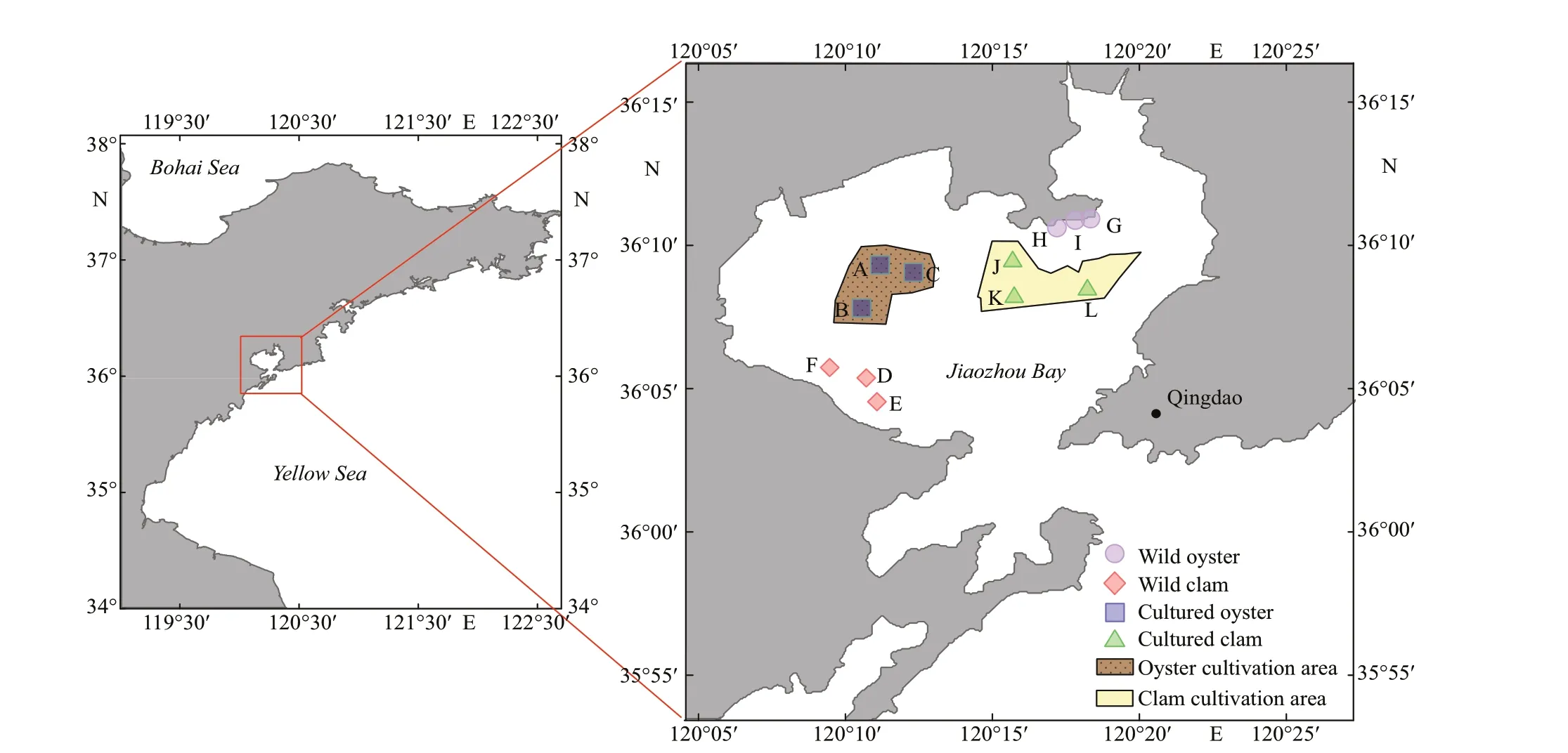
Fig.1 Map of Jiaozhou Bay showing the sampling stations
2.2 Microplastic extraction and identif ication
Thirty-three wild oysters, 33 farmed oysters, 20 wild clams, and 34 farmed clams were analyzed in this study. After complete thawing, the length, height,and width of the shell were measured with a Vernier caliper (0.02 mm), and the wet weight of soft tissue was weighed with a high-precision electronic balance(0.001 g).
The microplastic extraction protocol was adapted from Dehaut et al. (2016). The soft tissue of the mollusks was degraded with 10% KOH solution in f lasks placed in a water bath with oscillation at 60 ℃for 24 h. The conical f lasks were spaced evenly in the oscillator as far from one another as possible to ensure suffi cient oscillation. The degradation solution was f iltered (2.7-μm glass f iber f ilter, GF/D Whatman),and the equipment was washed with pure water to reduce the loss of microplastics. After f iltration, the f ilters were air-dried and stored in glass petri dishes away from light.
The microplastics were identif ied, counted,screened, and photographed under a stereoscopic microscope (Stemi SV11, Zeiss, Shanghai, China). To select potential targets, microplastics were analyzed according to shape, color, particle size, and other characteristics. Particle size was determined by measuring the longest length of the microplastics with camera software (Carl Zeiss AxioVision 4.9.1SP2).
All suspected microplastics were identif ied by a Nicolet iN 10 MX Fourier transform infrared (μFTIR)system (Thermo Fisher, USA). The spectral range was set at 4 000-675 cm-1in transmittance mode.Spectra were obtained by analysis with OMNIC 8.2 and compared with the spectral library in the software.Finally, the composition of the microplastics was determined from the types of functional groups determined from the spectra and matching degrees to the library spectra.
2.3 Quality control
During the experiment, precautions were taken to prevent airborne plastic contamination by exposure. All the experimental instruments were cleaned with pure water and dried before use. The glass petri dishes used to store the f ilters were heated in a muffl e furnace at 450 °C for 4 h, and all reagents, including pure water, were f iltered before use. During processing, doors and windows were closed, and the operator moved as little as possible to avoid microplastic interference caused by airf low. In addition, three groups of blank controls were analyzed with each batch of samples for correction.
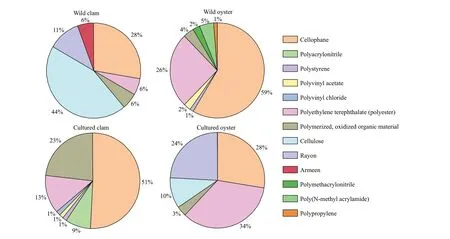
Fig.2 The polymer types in shellf ish from Jiaozhou Bay
2.4 Data analysis and statistics
The data were collected and analyzed according to the identif ication results. For statistical convenience,the particle was assigned to one of several distinct size classes at 500-μm intervals. The abundance of ingested microplastics (items/ind. or items/g) and the proportion of individuals with microplastics were calculated. Data management and statistical analysis were performed using SPSS 23.0. According to the results of the Kolmogorov-Smirnov test, the abundance of microplastics did not follow a normal distribution. Therefore, a nonparametric method(Mann-Whitney test) was used to analyze the diff erences (α=0.05) between various samples.
3 RESULT
3.1 Biological characteristics of shellf ish and ingestion of microplastics
Table 1 lists the biological characteristics, the frequency of individual organisms that ingested microplastics and the ingestion abundance of each sample in detail. Microplastics were observed in both groups ofC.gigasandR.philippinarumin Jiaozhou Bay. Combining wild and farmed individuals, the abundance of microplastics in oysters was 2.34±1.80 items/ind. or 0.92±0.80 items/g (wet weight,ww) and that in clams was 2.00±1.99 items/ind. or 1.51±1.27 items/g (ww). Nonparametric analysis revealed that there were no signif icant diff erences in the mean abundance of microplastics (items/g)between the diff erent sources of the same species(P1=0.59 for oyster andP2=0.50 for clam). Overall,the abundance of microplastics in shellf ish in Jiaozhou Bay ranged from 0.16 to 12.09 items/g (ww) or 1 to 9 items/ind., with an average of 1.21±1.52 items/g(ww) or 2.17±1.57 items/ind.
3.2 Chemical composition of microplastics in shellf ish
Among the microplastics ingested by the shellf ish of Jiaozhou Bay, cellophane was dominant in the polymer composition (48.48%). Polyethylene terephthalate (PET) (20.71%) and polymerized oxidized organic materials (10.61%) also accounted for considerable proportions, and these three polymers were all found in each sample group. Cellulose(5.56%) and rayon (4.55%) were also common.However, there was a higher frequency of cellulose than cellophane in the wild clams. Armeen was found in the wild clams only. The proportions of microplastics in each sample are shown in Fig.2.
3.3 Color of the microplastics

Fig.3 Diff erent color proportions of microplastics in shellf ish from Jiaozhou Bay
Black (42.97%) microplastics accounted for a large proportion of the microplastics ingested by shellf ish in Jiaozhou Bay. In addition, blue (20.31%),transparent (16.41%), and red (14.84%) microplastics were also common. Yellow and white were rare in Jiaozhou Bay. However, it can be clearly observed that some of the original bright colors of the plastics faded. There were some diff erences in the proportions of diff erent colors among the diff erent groups, and the color proportions in each group are shown in Fig.3.
3.4 Microplastic of limited shape in shellf ish
The microplastics in the shellf ish from Jiaozhou Bay were present only as f ibers and fragments (Fig.4);no other shapes (bead or f ilm) were found. Fibers dominated the shapes in each group and accounted for 92.97% of the total microplastics, while fragments accounted for only 7.03% (see Fig.5 for the proportions of each shape in each sample group).
3.5 Size characteristics of the microplastics detected

Fig.4 Photographs of microplastics under a stereoscopic microscope

Table 1 Biometric characteristics and microplastic ingestion for each group of samples

Fig.5 The shapes of microplastics in shellf ish from Jiaozhou Bay
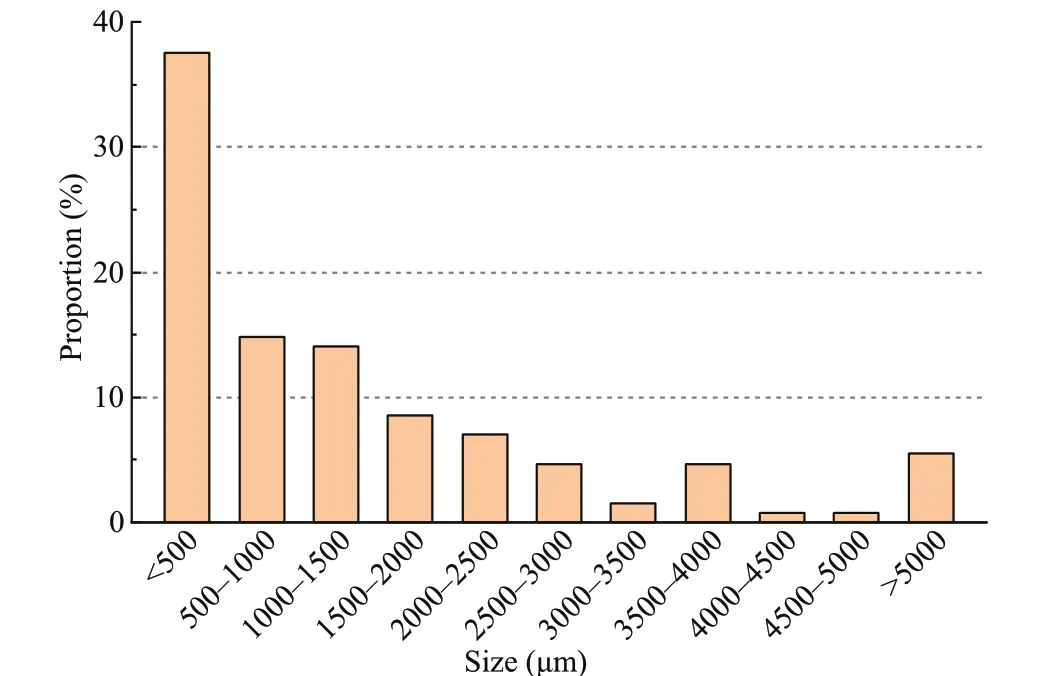
Fig.6 Total distribution of microplastic sizes in shellf ish from Jiaozhou Bay
The sizes of the microplastics detected in the shellf ish ranged from 15 to 8 201 μm in length. The proportions of microplastics with diff erent lengths are shown in Fig.6, which reveals that microplastics with lengths <500 μm accounted for the largest proportion(37.50%), and the proportion decreased as the size increased. Figure 7 shows the size proportions for each sample group.
4 DISCUSSION
4.1 The abundance of microplastics in shellf ish from Jiaozhou Bay
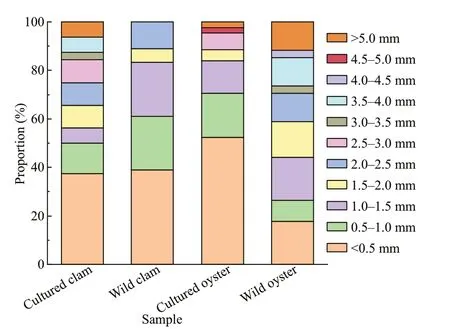
Fig.7 Distribution of microplastic sizes in shellf ish from Jiaozhou Bay
The abundance of microplastics in wild shellf ish was compared with that in farmed shellf ish through the Mann-Whitney test. There was no signif icant diff erence in the abundance of microplastics (items/g)between groups of the same species with diff erent growth modes (P1=0.50 for clams andP2=0.59 for oysters). That is, the growth patterns of shellf ish had no signif icant eff ect on their ingestion of microplastics.Most studies on microplastics selected mussels as the object of study, and similar results have been reported by de Witte et al. (2014) and Birnstiel et al. (2019). In contrast, de Witte et al. (2014) and Li et al. (2016)noted signif icant diff erences in microplastic abundance between wild and farmed mussels. The long distance between the sampling areas for the mussels with diff erent sources may have been the cause of these diff erences. However, Davidson and Dudas (2016) and Murphy (2018) studied clams(Venerupisphilippinarum) with diff erent growth patterns and found that the amount of microplastics in the body did not diff er much. Our f indings support these results very well. Research on oysters is limited.Phuong et al. (2018) found no signif icant diff erences between the two modes of life of Pacif ic oyster(C.gigas), which is similar to our result. Therefore,shellf ish grown in diff erent conditions contain the same level of microplastic pollution. When evaluating the safety of shellf ish products for consumption, from the perspective of microplastics, the inf luence of the growth pattern can be ignored.
The abundance of microplastics in oysters was 2.34±1.80 items/ind. or 0.92±0.80 items/g (ww) and that in clams was 2.00±1.99 items/ind. or 1.51±1.27 items/g (ww). Oysters are larger and contain signif icantly more soft tissue than clams at the individual level. In addition, according to the microplastic distribution, the intake of microplastics by oysters and clams is similar. Therefore, the unit should be items/g when comparing abundances. In this unit, the abundance of microplastics in clams is signif icantly greater than that in oysters, which has also been reported by Cho et al. (2019). The results show that clams are more likely to ingest microplastic particles. This indicates that diff erent shellf ish have diff erent ingestion capacities for microplastics inparticle selection. This may be due to their diff erent habitats. Oysters are usually sessile on reefs and remain still, while clams tend to drift with currents and move over a wider range. The limited habitat of oysters may limit their microplastic ingestion ability.

Table 2 Comparison of the results of this study with those of other studies
The abundance of microplastics in oysters(C.gigas) in the present study was higher than that in France (Phuong et al., 2018), South Korea (Cho et al.,2019), the USA (Rochman et al., 2015), and other areas in China (Li et al., 2018; Ran et al., 2018) but lower than that in the study by Murphy (2018) in Canada (Table 2). The microplastic abundance in clams (R.philippinarum) was also higher than that in South Korea (Cho et al., 2019) and Canada (Davidson and Dudas, 2016). Regarding both species, the abundance of microplastics in shellf ish in Jiaozhou Bay is higher than that in South Korea (Cho et al.,2019) and Iran (Naji et al., 2018) but lower than that in Shanghai, China (Li et al., 2015). This indicates that the microplastic pollution in Jiaozhou Bay is at a moderate level compared with those in other areas where monitoring results are available. The numerous rivers f lowing into Jiaozhou Bay, dense residential activities and considerable human activity may have contributed to the pollution in the region. Although the obtained results are not very concerning now, they still need to be taken seriously, and the lack of standardization of the sampling methods in published studies prevents intercomparison of the relative microplastic abundance in organisms worldwide.
4.2 Characteristics of microplastics in shellf ish from Jiaozhou Bay
Cellophane accounted for a large proportion of the detected microplastics. The microplastic composition can be used to trace the microplastic origin. Cellophane is a colorless transparent f ilm often used for packaging,which may explain the presence of transparent microplastics. The content of PET microplastics may be related to the discharge of laundry wastewater(Napper and Thompson, 2016) and packaging(Sobhani et al., 2020) into seawater. Cellulose made up more than half of the microplastics in the bodies of wild clams and was also found extensively in other studies (Scott et al., 2019; Bridson et al., 2020). The frequencies of microplastics composed of polypropylene (PP) and polyethylene (PE) in shellf ish were very low, close to zero. It was inferred that this resulted from their low density (0.90-0.91 g/cm3for PP, 0.92-0.97 g/cm3for PE, and 1.02 g/cm3for seawater), causing high buoyancy in seawater. The swimming and feeding capacity of benthic organisms are weak, so the proportion of these two components is low in such organisms. Armeen is an additive in the production of organic pigments and may be leached from coatings at f ishery facilities.
Microplastics smaller than 500 μm were the most common in the tested shellf ish, accounting for 37.50%of the total and indicating that shellf ish are more prone to ingest smaller microplastics. Filter-feeding shellf ish have a low feeding selectivity and often feed on microalgae (diatoms, chrysophytes, and chlorophytes are often used as feed) (Brown et al.,1997), the size of which is between 2-200 μm.Figure 6 shows that the preference of shellf ish for microplastics decreases with increasing microplastic size. It can be inferred that a large size can hinder microplastic intake, which may be related to the limitation of cilia functions.
Regarding shape, the majority of microplastics in the shellf ish were f ibers (92.97%), with fewer fragments. This result is consistent with the research results of many scholars on microplastic shapes in shellf ish. Zheng et al. (2019) reported that the proportion of f ibrous microplastics in seawater and sediments in Jiaozhou Bay was 93.11%, which is consistent with our experimental results. Most of the microplastics in seawater and sediment were black,followed by blue and red (transparent microplastics were not counted in their study). In this study, the dominant colors of microplastics were as follows:black (42.97%), blue (20.31%), transparent (16.41%),and red (14.84%); this is consistent with the study described above. The shape and color distributions of the microplastics in shellf ish from Jiaozhou Bay were similar to those in seawater and sediments. Therefore,we can conclude that the feeding of shellf ish on microplastics is greatly inf luenced by their habitat.
4.3 Risk assessment of shellf ish consumption
The production of shellf ish in China has been increasing (National Bureau of Statistics, 2018). It is important to determine the level of microplastic contamination of shellf ish and the potential risk posed by their consumption to humans. When people eat shellf ish, they tend to eat all of the soft tissue.Therefore, diet is generally considered an important source of microplastics for humans (Galloway, 2015;Prata et al., 2020). The average shellf ish consumption of a Chinese individual is 2.62 kg/(capita·a) (National Bureau of Statistics, 2018). However, the consumption of coastal residents is even higher; for example,residents of Hainan Province (30.81 kg/(capita·a))consume far more than the average Chinese population(Gu et al., 2015). One diff erence to note is that the statistical consumption generally refers to the total weight of shellf ish, while the abundance of microplastics in this study represents the weight per unit of soft tissue (Zhang et al., 2020). Because soft tissue weight is typically 40% of the total weight, it can be inferred that the average microplastic consumption through the Chinese diet is 1.27×103items/(capita·a). In coastal areas with high shellf ish intake, the consumption per capita can be greater. A comparison with the results of Cho et al.(2019) (212 items/(capita·a)) revealed that the Chinese dietary intake of microplastics through shellf ish is higher than the Korean dietary intake. According to Hantoro et al. (2019), the estimated global intake of microplastics through mollusk consumption varies between (0-1.31)×104particles/(capita·a). Our results fall at the low level of this range. Wu et al. (2020)concluded that the accumulation of microplastics(~2 items/ind.) in commercial species in Xiangshan Bay in China was negligible. Combining our results with the results of this study indicates that microplastics may pose low health risks via shellf ish consumption in China. However, such risks still deserve attention, and more research needs to be conducted.
Zhang et al. (2020) compared human microplastic exposure through diff erent pathways and found that the human body burden resulting from inhalation was estimated to be (0-3)×107items per person per year.This is signif icantly higher than the microplastic burden from dietary exposure in this study. Therefore,from a quantitative perspective, the risks posed by dietary microplastic intake are less concerning than those posed by respiratory intake.
5 CONCLUSION
It is common for shellf ish with important economic and ecological performance to ingest microplastics.The results of this study provide important insights:microplastic pollution in Jiaozhou Bay is at a moderate level compared with that in other known areas, but actions for controlling plastic pollution in Jiaozhou Bay, China, are needed. Shellf ish prefer to eat small microplastics. Moreover, for shellf ish, black is the preferred color, and f ibers are the preferred shape.Cellophane and PET are the predominant microplastic types in shellf ish from Jiaozhou Bay. Clams have a higher ingestion abundance than oysters. Wild and farmed growth modes had no signif icant eff ect on the microplastic feeding of shellf ish. Dietary intake of microplastics through shellf ish consumption poses a low risk to humans. Further studies are required on the risk assessment of microplastics from human seafood consumption.
6 DATA AVAILABILITY STATEMENT
The data generated or analyzed during the current study are available from the corresponding author on reasonable request.
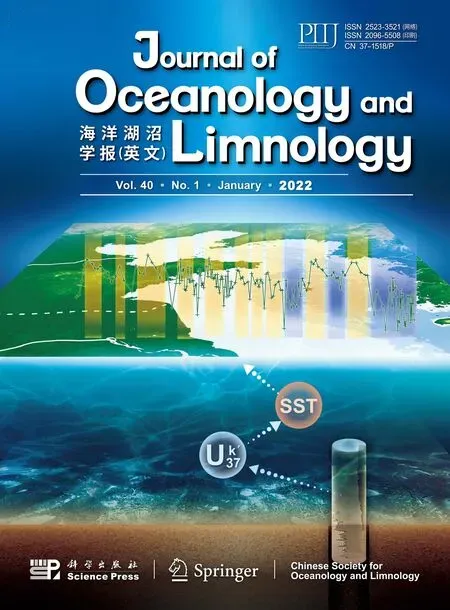 Journal of Oceanology and Limnology2022年1期
Journal of Oceanology and Limnology2022年1期
- Journal of Oceanology and Limnology的其它文章
- The adjoint-based Two Oceans One Sea State Estimate(TOOSSE)*
- Structure and formation of the South Yellow Sea water mass in the spring of 2007*
- Lagrangian eddies in the Northwestern Pacif ic Ocean*
- Seasonal variability in dissolved oxygen in the Bohai Sea,China*
- In-situ experiments reveal mineralization details of porphyry copper deposits
- Chemical composition and Pb(II) binding of dissolved organic matter in a hypersaline lake in China*
